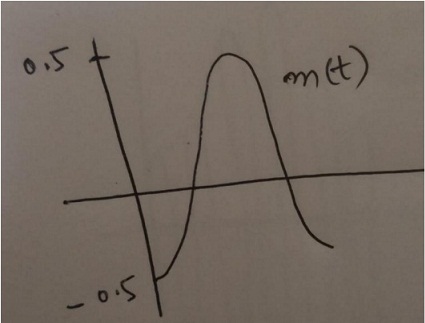Assignment
1. Convert the binary data "011010" into analog waveforms using following modulation techniques:
a. Two level Amplitude Shift Keying
b. Two level Frequency Shift Keying
c. Two level Phase Shift Keying
d. Differential Phase shift keying
e. Four level Amplitude Shift Keying
f. Four level Phase Shift Keying
g. Eight level Amplitude Shift Keying
2. With fc = 500 kHz, fd = 25 kHz, and M = 16 (L = 4 bits), compute the frequency assignments for each of the sixteen possible 4-bit data combinations.
3. Draw the approximate Analog Modulation and Frequency Modulation waveforms in complete steps for the following signal:

4. Draw the 16 QAM Constellation Diagram having two different amplitude levels and eight different phase levels.
5. Explain and draw the Error Detection Process for Cyclic Redundancy Check (CRC).
6. Compute the frame check sequence for the following information:
Message = 10111100, Pattern = 11011
7. Compute the transmitted signal using Direct Sequence Spread Spectrum for the following information:
Input: 1011, Locally Generated PN bit stream: 101011011010, T = 3Tc
8. What is the difference between Infrastructure and ad hoc modes in WLAN? Draw their relative diagrams as well.
9. Compare the differences of TCP and OSI protocols for wired and wireless LANs using diagrams.
10. Explain why the square and circle shapes cells for cellular communications are not appropriate as compared to hexagonal shape cells.
Format your assignment according to the following formatting requirements:
1. The answer should be typed, double spaced, using Times New Roman font (size 12), with one-inch margins on all sides.
2. The response also includes a cover page containing the title of the assignment, the student's name, the course title, and the date. The cover page is not included in the required page length.
3. Also include a reference page. The Citations and references should follow APA format. The reference page is not included in the required page length.